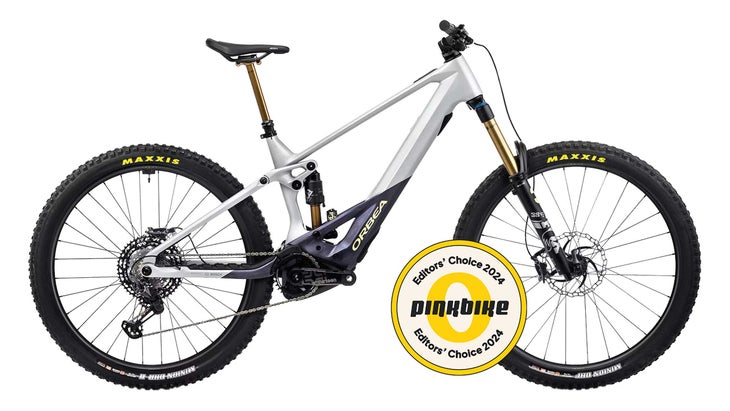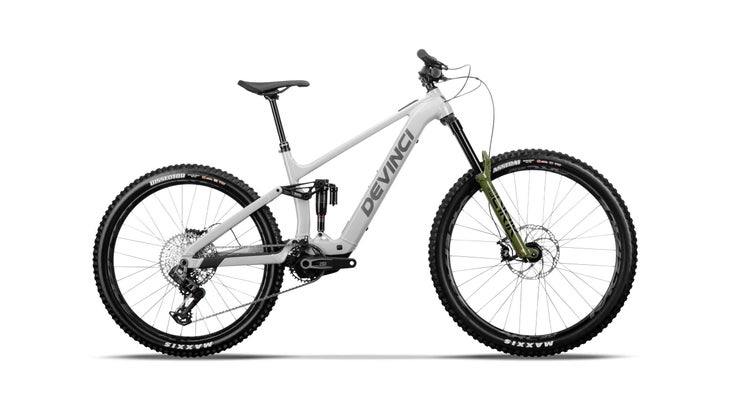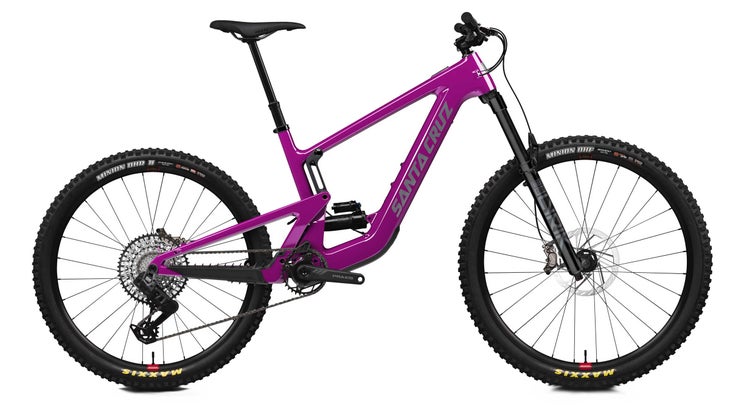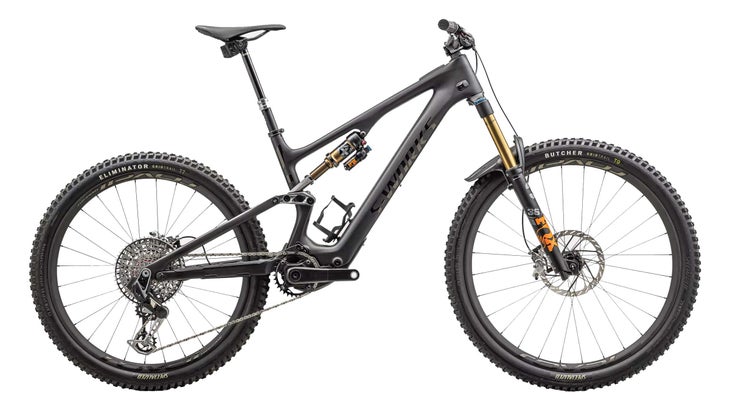The electric-mountain bike market has grown exponentially in the last decade, and this year’s options are better than ever. Whether you’re looking for an option that feels the same as a regular mountain bike or you want a hard-charging chop-crusher, we singled out the best four of the year.
We tested eight bikes this year from Bellingham to Squamish, and these four performed the best.
At a Glance
All gear in this guide was tested by multiple reviewers. If you buy through our links, we may earn an affiliate commission. This supports our mission to get more people active and outside. Learn more.

Editor’s Choice
Orbea Wild M-LTD
Build: M-LTD
Weight: 49.8 lbs (size L)
Pros and Cons
⊕ Extremely calm and composed
⊕ Powerful Bosch motor with wireless controller, display
⊗ No mixed wheel options in any sizes
Orbea’s new Wild eMTB arrived at the party with revised geometry, a stiffer frame, and Bosch’s latest CX Race motor. All of the models roll on 29-inch wheels and have 160-millimeters of rear travel, but Orbea’s MyO program allows for a wide range of configuration options. Riders can select from a 160 or 170-millimeter fork, a 625-watt-hour or 750-watt-hour battery, the option to add on a display or light package, and to customize the paint scheme.
Orbea did a great job eliminating any unnecessary bells and whistles on the Wild. All too often, e-mountain bikes have big displays, awkward remotes, and a rat’s nest of wires cluttering the cockpit. With the Wild, there’s a small wireless remote on the left-hand side of the handlebar, Bosch’s System Controller integrated into the top tube—and that’s it. It’s clean, effective, and there aren’t any vulnerable delicate parts waiting to get smashed to bits in a crash.
A series of LED lights indicate the battery level, and another light at the top of the display shows what mode the bike is in. There are four levels: Eco, Tour+, eMTB, and Race. It’s possible to add on Bosch’s Kiox display for riders that want to see more information at a glance, but I’m a fan of the less is more approach—knowing what the mode and the battery percentage is all the information I need.
The Wild will blast up short, punchy climbs with ease, but it’s also possible to creep up extra-steep, technical sections the way a rock crawler would. Grab some brake here, a half-pedal stroke there, top it off with a final out-of-the-saddle lunge, and the Wild will get up some seriously awkward sections of trail. The high-end Bosch motor plays a large role in this equation, but the geometry shouldn’t be overlooked. The seated climbing position is upright and centers the rider between the wheels, reducing the number of times you’ll need to make dramatic weight shifts to maintain traction. When it is time to stand up, the higher front end makes it easier to lift the front end up and over obstacles.
Bigger jumps and drops didn’t pose any problems, and even when I used all of the travel there wasn’t any unwanted clanking or harshness at the end of the stroke. It’s the sort of bike that makes you want to go fast, just to see what will happen.
The new Wild may have been designed with racing in mind, but there’s no need to go near a race course to enjoy it. It’s fast, powerful, and incredibly composed while climbing and descending, making it an excellent all-rounder for riders who prefer their trails on the trickier, more technical side.

Best Lightweight e-MTB
Devinci E-Troy Lite
Build: GX AXS 12S
Weight: 43 lbs (size M)
Pros and Cons
⊕ Confident and playful descender
⊕ Top-performing and natural-feeling Bosch motor
⊕ Excellent value for components and a Made in Canada frame
⊗ The walk mode isn’t the easiest to use
⊗ Noisy on the downhill
The new Devinci E-Troy Lite will convert the e-mountain bike skeptics out there. It delivers power so seamlessly and naturally that it makes you feel like you’re a fitter version of yourself on the climbs. Not only is the climbing smooth and enjoyable, but the E-Troy Lite is a supremely confident descender with well-balanced suspension.
We reviewed Devinci’s full-powered E-Troy back in January before the Canadian brand released the E-Troy Lite this spring, Devinci’s first lightweight e-mountain bike. It comes with a Bosch Performance Line SX motor with 55 Newton-meters of torque compared to the 85 Newton-meters of torque on the full-powered bike and has a smaller battery as well. With the same amount of travel but a slightly steeper headtube angle, the E-Troy Lite weighs over 10 pounds less than the full-powered bike. All sizes of the E-Troy Lite have mixed wheels.
While climbing, there are four assist modes that are easy to toggle through using the small wireless shifter on the thumb-actuated mini remote. While on eMTB mode, it really feels like you’re being rewarded for putting down watts since the motor reacts to rider input. I spent the majority of the time in the Tour+ (second) and eMTB (third) modes on singletrack climbs since they provided the perfect amount of assistance without burning through the battery or feeling like they were overpowering me. I never felt like I needed to jam on the brakes on a climb, which is certainly a feeling I’ve had with some full-powered eMTBs. Without a range extender, I found that the E-Troy Lite could do an 18-mile ride with about 3,200 feet of climbing (though that number will change based on your effort, the mode, your weight, and the trails).
There are some bikes that you just feel comfortable on out of the box while descending, and the E-Troy Lite is absolutely one of them. The geometry is dialed with a 63.6-degree head tube angle, putting you in a confident and strong position when things get steep and rough. While the bike is able to track well and absorb trail chatter, it also feels lively and light, thanks to the active suspension. My current daily rider weighs around 34 pounds, so the extra weight of the E-Troy Lite doesn’t feel as unwieldy as a full-powered e-mountain bike does. Most importantly, I found the E-Troy Lite perfectly manageable to slow down and control on descents, which isn’t something that I take for granted on a full-powered eMTB. There’s still more fatigue in my hands at the end of a long descent than on a lighter bike, but decidedly less so than on a full-powered eMTB.
While it’s a touch noisy on the descents, the E-Troy Lite makes up for it by being a joy to both climb and descend. In addition, the aluminum frame is made in Canada and the parts are well-selected for the bike’s intended use and it comes at a reasonable price. —Sarah Moore

Best for Quick Lunch Breaks
Santa Cruz Heckler SL
$9,699 at Backcountry $9,699 at Competitve Cyclist
Build: GX AXS
Weight: 42.6 lbs (size L)
Pros and Cons
⊕ Relatively light, making it easy to handle
⊕ Quiet and unobtrusive motor
⊗ Smaller battery limits max ride length
The Heckler SL is powered by Fazua’s Ride 60 motor and a 430-watt-hour battery, a relatively light system that keeps the bike’s weight in the low 40-pound range. The frame has a much slimmer look than the full-powered Heckler, and from a distance, it doesn’t immediately stand out as an e-MTB. All models roll on mixed wheels, with a 160-millimeter fork and 150 millimeters of rear travel.
Climbing on the Heckler SL is a calm and quiet affair, especially in the lower two motor modes. The noise increases slightly with the highest level of assistance, but it’s still pretty subdued. The maximum level of assistance is similar to the middle “Trail” mode of a full-powered eMTB, which gives it a less frantic feeling on singletrack, and means there’s less chance of inadvertently pedaling yourself off the trail.
On the descents, the Heckler SL delivers a very impressive level of grip, especially when it comes to maintaining traction on slippery, off-camber sections of trail. It sticks to the ground incredibly well when necessary, but it’s also a good jumper. It’s noticeably easier to bunnyhop or pop off natural lips compared to a heavier, full-powered e-MTB, and its composed nature in the air is reminiscent of how a downhill bike feels.
Choosing between a mid-power e-MTB and a full-power option really comes down to what sort of ride experience you’re looking for. The handling of a bike like the Heckler SL feels much closer to a non-motorized mountain bike, and it could be the ticket for riders looking to squeeze more miles during a lunch or after-work ride.

Best Race e-MTB
Canyon StriveOn
Build: CFR LTD
Weight: 50.9 lbs (size L)
Pros and Cons
⊕ Relatively light, making it easy to handle
⊕ Quiet and unobtrusive motor
⊗ Smaller battery limits max ride length
Canyon’s new StriveOn has a penchant for racing, with an unabashedly full-powered 85Nm of torque and a maximum 600-watt power output delivered by the Bosch CX motor. The highest-end model can be equipped with Bosch’s CX Race motor, which is 150 grams lighter and provides extra overrun in Race mode for an additional climbing boost.
The geometry of the StriveOn isn’t too far off from its non-electric counterpart but with the notable omission of the Strive’s adjustability. Starting from the Strive’s downhill position, the Strive:On gets longer chainstays and a steeper seat tube angle to better navigate tech climbing, plus a shorter reach in the handlebars to keep the bike maneuverable.
With four size options, and a reach range from 450 to 525 millimeters, the fit of the StriveOn is definitely biased towards bigger riders. Canyon’s reach numbers are generally pretty aggressive for how long they are per size, but riders looking to size down for more agility will hit the low end of the range pretty quickly. Looking at the StriveOn as a standard enduro bike, it’s simply a well-sorted machine, with great geometry and handling characteristics. Where the head angle and reach might seem a bit extreme relative to current high-level pedal bikes, the extra system weight makes that long reach and slack front end feel calmer than you’d expect.
All told, the StriveOn proved to be an excellent bike for tackling gnarly terrain. The Strive is eager to remind you that you’re on an ebike on the climbs, but there were plenty of moments on the descents where the extra bulk faded away, making for some truly excellent runs.

Best All-Around E-MTB
Specialized Turbo Levo SL
Build: S-Works
Weight: 39.3 lbs (size S4)
Pros and Cons
⊕ Lightweight for a 50Nm eMTB
⊕ Adaptable for most riding zones or style
⊕ Plush suspension is the right amount of active
⊗ Expensive
⊗ Main battery isn’t easily removable
In my mind, the Levo SL is the pinnacle of what e-bikes could be—or all bikes, for that matter. First, it weighs as much as some enduro bikes, which includes its motor. This S-Works model is shod with the cream of the crop components; Fox Factory suspension that is tuned specifically by Specialized, SRAM’s bulletproof XX Transmission shifting, and carbon nearly everywhere possible on the bike.
As for that tiny motor, it’s gained 15Nm of torque over the previous generation (50Nm up from 35). A tidy display screen that can be personalized using the straightforward Specialized app is built into the top tube. On the handlebars, you can shuffle through a few of the chosen screens, toggle the assist, and activate the walk mode with ease. A 320Wh battery is located in the downtube. If you’re looking for extra juice, a 160-watt-hour range extender nestles into the bottle cage and firmly locks onto the charge port.
Its impeccable FSR suspension handles everything from stutter bumps to eroded downhill tracks. The whole time we rode it, the chain and motor clutch barely made a peep. That’s perhaps the best part of all—the silence and buttery suspension make it easy to forget that you’re ripping downhill with a motor hidden in the frame.
Bottom Line: It can be as aggressive as current downhill bikes, or as upright as some cross-country mountain bikes. It works for hauling down the steeps or remaining sharp in rolling terrain. Overall, it’s just about as adaptable as its motorless sibling, the Stumpjumper Evo.
How to Choose an E-Mountain Bike
Electric bikes have evolved at a break-neck speed in the past five years or so, transforming from huge, bulky beasts into much more refined and svelte electric machines. Though there is still ample room for progress, many of the problems with the first couple of generations of ebikes have been smoothed out. However, buying an e-mountain bike has become even more of a project thanks to all of the new tech that has come out to solve said problems.
For a full rundown on how to buy an e-mountain bike in our current market, check out PinkBike’s guide. Managing tech editor Mike Kazimer provides tips by asking questions like: what are you friends riding? How far do you typically go? What type of riding are you planning on doing? How much money do you want to spend? Of course, you can opt to go for a regular mountain bike that isn’t motored, but if you’re set on going electric, make sure you’re paying close attention to these factors.
How We Test
- Number of Bikes Tested: 8
- Number of Testers: 3
The bikes included in this roundup are the result of rolling testing done in Whistler, Squamish, and Bellingham throughout the year by the Pinkbike crew. We also rode some bikes at Crankworx Whistler, one of a multi-stop series of mountain bike festivals put on at multiple locations around the world every year.
Conditions ranged from dusty, rutted-out downhill trails to muddy, technical rides in the rainforest of Squamish. We took some bikes out for over six months and tested them in as many different types of trails as possible. Testers particularly considered the electric mountain bike’s climbing prowess, descending abilities, and sound levels.
Meet Our Lead Testers
Mike Kazimer: Managing tech editor for Pinkbike, alien skeptic.
Dario DiGiulio: Tech editor for PinkBike, based in Bellingham, WA.
Matt Beer: Tech editor for Pinkbike, former World Cup Downhill racer.
